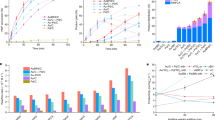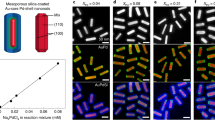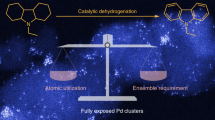Abstract
Particle size governs the geometric and electronic structure of metal nanoparticles (NPs), shaping their catalytic performance. However, size-dependent entanglement in the geometric and electronic structures often leads to a trade-off between activity and selectivity, limiting the optimization of the overall catalytic performance. Here we show that precisely controlled deposition of a platinum monolayer on large gold NPs breaks the activity–selectivity trade-off on particle size in platinum-catalysed chemoselective hydrogenation of halonitrobenzenes, resulting in a remarkable activity, along with a 99% selectivity for haloanilines under mild conditions. The high activity results from upshift of the platinum 5d-band centre through platinum lattice expansion and ligand effect, whereas the high selectivity is caused by exposing more terrace sites on large particles. The geometric and electronic properties of bimetallic monolayer materials, distinct from monometallic NPs and alloys, constitute a promising platform for the rational design of metal catalysts with superior performance in hydrogenation reactions.

This is a preview of subscription content, access via your institution
Access options
Access Nature and 54 other Nature Portfolio journals
Get Nature+, our best-value online-access subscription
$29.99 / 30 days
cancel any time
Subscribe to this journal
Receive 12 digital issues and online access to articles
$119.00 per year
only $9.92 per issue
Buy this article
- Purchase on Springer Link
- Instant access to full article PDF
Prices may be subject to local taxes which are calculated during checkout





Similar content being viewed by others
Data availability
The data generated during this study are included in this article (and its Supplementary Information files) or can be obtained from the authors upon reasonable request.
References
Calle-Vallejo, F. et al. Finding optimal surface sites on heterogeneous catalysts by counting nearest neighbors. Science 350, 185–189 (2015).
Calle-Vallejo, F., Loffreda, D., Koper, M. T. M. & Sautet, P. Introducing structural sensitivity into adsorption-energy scaling relations by means of coordination numbers. Nat. Chem. 7, 403–410 (2015).
den Breejen, J. P. et al. On the origin of the cobalt particle size effects in Fischer–Tropsch catalysis. J. Am. Chem. Soc. 131, 7197–7203 (2009).
Kuhn, J. N., Huang, W. Y., Tsung, C. K., Zhang, Y. W. & Somorjai, G. A. Structure sensitivity of carbon–nitrogen ring opening: impact of platinum particle size from below 1 to 5 nm upon pyrrole hydrogenation product selectivity over monodisperse platinum nanoparticles loaded onto mesoporous silica. J. Am. Chem. Soc. 130, 14026–14027 (2008).
Reske, R., Mistry, H., Behafarid, F., Cuenya, B. R. & Strasser, P. Particle size effects in the catalytic electroreduction of CO2 on Cu nanoparticles. J. Am. Chem. Soc. 136, 6978–6986 (2014).
Englisch, M., Jentys, A. & Lercher, J. A. Structure sensitivity of the hydrogenation of crotonaldehyde over Pt/SiO2 and Pt/TiO2. J. Catal. 166, 25–35 (1997).
Cao, S. W., Tao, F., Tang, Y., Li, Y. T. & Yu, J. G. Size- and shape-dependent catalytic performances of oxidation and reduction reactions on nanocatalysts. Chem. Soc. Rev. 45, 4747–4765 (2016).
Halperin, W. P. Quantum size effects in metal particles. Rev. Mod. Phys. 58, 533–606 (1986).
Li, L. et al. Investigation of catalytic finite-size-effects of platinum metal clusters. J. Phys. Chem. Lett. 4, 222–226 (2013).
Wang, A. Q., Liu, X. Y., Mou, C. Y. & Zhang, T. Understanding the synergistic effects of gold bimetallic catalysts. J. Catal. 308, 258–271 (2013).
Shi, J. L. On the synergetic catalytic effect in heterogeneous nanocomposite catalysts. Chem. Rev. 113, 2139–2181 (2013).
Liu, L. C. & Corma, A. Metal catalysts for heterogeneous catalysis: from single atoms to nanoclusters and nanoparticles. Chem. Rev. 118, 4981–5079 (2018).
Zhang, L. L., Zhou, M. X., Wang, A. Q. & Zhang, T. Selective hydrogenation over supported metal catalysts: from nanoparticles to single atoms. Chem. Rev. 120, 683–733 (2020).
Zhao, M. T. et al. Metal–organic frameworks as selectivity regulators for hydrogenation reactions. Nature 539, 76–80 (2016).
Blaser, H. U., Steiner, H. & Studer, M. Selective catalytic hydrogenation of functionalized nitroarenes: an update. ChemCatChem 1, 210–221 (2009).
Jones, C. R., Liu, Y. Y., Sepai, O., Yan, H. F. & Sabbioni, G. Internal exposure, health effects, and cancer risk of humans exposed to chloronitrobenzene. Environ. Sci. Technol. 40, 387–394 (2006).
Zhang, P. P. et al. Kinetically stabilized Pd@Pt core–shell octahedral nanoparticles with thin Pt layers for enhanced catalytic hydrogenation performance. ACS Catal. 5, 1335–1343 (2015).
Liu, M. et al. Design of highly efficient Pt–SnO2 hydrogenation nanocatalysts using Pt@Sn core–shell nanoparticles. ACS Catal. 7, 1583–1591 (2017).
Cardenas-Lizana, F. et al. Selective gas phase hydrogenation of p-chloronitrobenzene over Pd catalysts: role of the support. ACS Catal. 3, 1386–1396 (2013).
Xu, Q., Liu, X. M., Chen, J. R., Li, R. X. & Li, X. J. Modification mechanism of Sn4+ for hydrogenation of p-chloronitrobenzene over PVP-Pd/γ-Al2O3. J. Mol. Catal. A Chem. 260, 299–305 (2006).
Cai, S. F. et al. Highly active and selective catalysis of bimetallic Rh3Ni1 nanoparticles in the hydrogenation of nitroarenes. ACS Catal. 3, 608–612 (2013).
Wang, C. P. et al. Insight into single-atom-induced unconventional size dependence over CeO2-supported Pt catalysts. Chem 6, 752–765 (2020).
Corma, A. & Serna, P. Chemoselective hydrogenation of nitro compounds with supported gold catalysts. Science 313, 332–334 (2006).
Boronat, M. et al. A molecular mechanism for the chemoselective hydrogenation of substituted nitroaromatics with nanoparticles of gold on TiO2 catalysts: a cooperative effect between gold and the support. J. Am. Chem. Soc. 129, 16230–16237 (2007).
Gong, H. H. et al. Atomically precise Ag nanoclusters intercalated in zirconium pyrophosphate for efficient hydrogenation of nitroaromatics. Appl. Catal. A: Gen. 574, 1–9 (2019).
Chen, Y. Y., Wang, C. A., Liu, H. Y., Qiu, J. S. & Bao, X. H. Ag/SiO2: a novel catalyst with high activity and selectivity for hydrogenation of chloronitrobenzenes. Chem. Commun. 5298–5300 (2005).
Serna, P., Concepcion, P. & Corma, A. Design of highly active and chemoselective bimetallic gold–platinum hydrogenation catalysts through kinetic and isotopic studies. J. Catal. 265, 19–25 (2009).
Makosch, M. et al. Organic thiol modified Pt/TiO2 catalysts to control chemoselective hydrogenation of substituted nitroarenes. ACS Catal. 2, 2079–2081 (2012).
Cao, L. N. et al. Atomically dispersed iron hydroxide anchored on Pt for preferential oxidation of CO in H2. Nature 565, 631–635 (2019).
Wang, H. W. et al. Disentangling the size-dependent geometric and electronic effects of palladium nanocatalysts beyond selectivity. Sci. Adv. 5, 8 (2019).
Kleis, J. et al. Finite size effects in chemical bonding: from small clusters to solids. Catal. Lett. 141, 1067–1071 (2011).
Lu, J. L. et al. Toward atomically-precise synthesis of supported bimetallic nanoparticles using atomic layer deposition. Nat. Commun. 5, 3264 (2014).
Baker, L. et al. Nucleation and growth of Pt atomic layer deposition on Al2O3 substrates using (methylcyclopentadienyl)-trimethyl platinum and O2 plasma. J. Appl. Phys. 109, 084333 (2011).
Le Bars, J., Specht, U., Bradley, J. S. & Blackmond, D. G. A catalytic probe of the surface of colloidal palladium particles using Heck coupling reactions. Langmuir 15, 7621–7625 (1999).
Qiu, L. M., Liu, F., Zhao, L. Z., Yang, W. S. & Yao, J. N. Evidence of a unique electron donor–acceptor property for platinum nanoparticles as studied by XPS. Langmuir 22, 4480–4482 (2006).
Bai, L. C. et al. Explaining the size dependence in platinum-nanoparticle-catalyzed hydrogenation reactions. Angew. Chem. Int. Ed. 55, 15656–15661 (2016).
Wang, G. W. et al. Pt skin on AuCu intermetallic substrate: a strategy to maximize Pt utilization for fuel cells. J. Am. Chem. Soc. 136, 9643–9649 (2014).
Singh, J., Lamberti, C. & van Bokhoven, J. A. Advanced X-ray absorption and emission spectroscopy: in situ catalytic studies. Chem. Soc. Rev. 39, 4754–4766 (2010).
de Groot, F. High resolution X-ray emission and X-ray absorption spectroscopy. Chem. Rev. 101, 1779–1808 (2001).
Gallezot, P., Weber, R., Dallabetta, R. A. & Boudart, M. Investigation by X-ray absorption spectroscopy of platinum clusters supported on zeolites. Z. Naturforsch. A Phys. Sci. 34, 40–42 (1979).
Lytle, F. W. Determination of d-band occupancy in pure metals and supported catalysts by measurement of L3 X-ray absorption threshold. J. Catal. 43, 376–379 (1976).
Ding, K. et al. Identification of active sites in CO oxidation and water-gas shift over supported Pt catalysts. Science 350, 189–192 (2015).
Wang, C. L. et al. Water-mediated Mars–Van Krevelen mechanism for CO oxidation on ceria-supported single-atom Pt1 catalyst. ACS Catal. 7, 887–891 (2016).
Davidson, E. R., Kunze, K. L., Machado, F. B. C. & Chakravorty, S. J. The transition-metal carbonyl bond. Acc. Chem. Res. 26, 628–635 (1993).
Mott, D. et al. Nanocrystal and surface alloy properties of bimetallic gold–platinum nanoparticles. Nanoscale Res. Lett. 2, 12–16 (2007).
Rodriguez, J. A. & Kuhn, M. Chemical and electronic properties of Pt in bimetallic surfaces: photoemission and CO-chemisorption studies for Zn/Pt(111). J. Chem. Phys. 102, 4279–4289 (1995).
Bourgeat-Lami, E. & Lang, J. Encapsulation of inorganic particles by dispersion polymerization in polar media: 2. Effect of silica size and concentration on the morphology of silica–polystyrene composite particles. J. Colloid Interface Sci. 210, 281–289 (1999).
Wang, H. W., Wang, C. L., Yan, H., Yi, H. & Lu, J. L. Precisely-controlled synthesis of Au@Pd core–shell bimetallic catalyst via atomic layer deposition for selective oxidation of benzyl alcohol. J. Catal. 324, 59–68 (2015).
Perdew, J. P., Burke, K. & Ernzerhof, M. Generalized gradient approximation made simple. Phys. Rev. Lett. 77, 3865–3868 (1996).
Klimes, J., Bowler, D. R. & Michaelides, A. Van der Waals density functionals applied to solids. Phys. Rev. B 83, 195131 (2011).
Klimeš, J., Bowler, D. R. & Michaelides, A. Chemical accuracy for the van der Waals density functional. J. Phys. Condens. Matter 22, 022201 (2010).
Perdew, J. P. et al. Restoring the density-gradient expansion for exchange in solids and surfaces. Phys. Rev. Lett. 102, 1 (2009).
Blochl, P. E. Projector augmented-wave method. Phys. Rev. B 50, 17953–17979 (1994).
Henkelman, G., Uberuaga, B. P. & Jonsson, H. A climbing image nudged elastic band method for finding saddle points and minimum energy paths. J. Chem. Phys. 113, 9901–9904 (2000).
Li, L. et al. Investigation of catalytic finite-size-effects of platinum metal clusters. J. Phys. Chem. Lett. 4, 222–226 (2012).
Methfessel, M. & Paxton, A. T. High-precision sampling for Brillouin-zone integration in metals. Phys. Rev. B 40, 3616–3621 (1989).
Acknowledgements
J.L. acknowledges support from the National Natural Science Foundation of China (22025205, 21673215), the Dalian National Laboratory for Clean Energy (DNL) Cooperation Fund (DNL201907), the Fundamental Research Funds for the Central Universities (WK2060030029), and Users with Excellence Program of Hefei Science Center CAS (2019HSC-UE016). W.-X.L. acknowledges the National Key R&D Program of China (2018YFA0208603), the National Natural Science Foundation of China (91945302), the Dalian National Laboratory for Clean Energy (DNL) Cooperation Fund (DNL201920), the Chinese Academy of Sciences (QYZDJ-SSW-SLH054) and K.C. Wong Education (GJTD-2020-15). Y.L. acknowledges support from the Youth Innovation Promotion Association of the CAS (2020458). Y.Y. acknowledges support from the National Natural Science Foundation of China (22072092, 92045301). S.W. acknowledges the National Key R&D Program of China (2017YFA0402800). The authors all gratefully thank the BL14W1 beamline at the Shanghai Synchrotron Radiation Facility (SSRF) and Supercomputing Center of University of Science and Technology of China and National Supercomputing Center in Zhengzhou.
Author information
Authors and Affiliations
Contributions
J.L. designed the experiments and W.-X.L. designed the DFT calculations. Q.G. synthesized and characterized the catalysts and evaluated the catalytic performance. C.Z. did the DFT calculations. Y.L. did the HAADF-STEM measurements. E.I.V., X.Z. and Y.Y. did the XPS measurements. H.Y., L.C., H.W., X.Z., X.L. and M.Z. assisted the catalyst characterization and catalytic performance evolution. S.W. performed the XAFS measurements. J.L. and W.-X.L. co-wrote the manuscript, and all the authors contributed to the overall scientific interpretation and edited the manuscript.
Corresponding authors
Ethics declarations
Competing interests
The authors declare no competing interests.
Additional information
Peer review Information Nature Catalysis thanks Meenakshisundaram Sankar and the other, anonymous, reviewer(s) for their contribution to the peer review of this work.
Publisher’s note Springer Nature remains neutral with regard to jurisdictional claims in published maps and institutional affiliations.
Supplementary information
Supplementary Information
Supplementary Figs. 1–36, Tables 1–9 and References.
Supplementary Data 1
A zipped file containing the source data of Supplementary Figs. 1–35 and DFT-calculated coordination parameters. Therein, the file Supplementary_Figures_1-7,10,14,21,23,27-35 corresponds to the original data in the supplementary figures, while the file XYZ_coordination_parameters.docx contains the atomic coordinates of the optimized DFT models used in this article.
Source data
Source Data Fig. 1
Statistical Source Data
Source Data Fig. 2
Statistical Source Data
Source Data Fig. 3
Statistical Source Data
Source Data Fig. 4
Statistical Source Data
Source Data Fig. 5
Statistical Source Data
Rights and permissions
About this article
Cite this article
Guan, Q., Zhu, C., Lin, Y. et al. Bimetallic monolayer catalyst breaks the activity–selectivity trade-off on metal particle size for efficient chemoselective hydrogenations. Nat Catal 4, 840–849 (2021). https://doi.org/10.1038/s41929-021-00679-x
Received:
Accepted:
Published:
Issue Date:
DOI: https://doi.org/10.1038/s41929-021-00679-x
This article is cited by
-
Lattice engineered nanoscale Fe0 for selective reductions
Nature Water (2024)
-
Strategies to improve hydrogen activation on gold catalysts
Nature Reviews Chemistry (2024)
-
Modulation in the electronic structure of Ir-rich shell on AuIr solid solution as OER electrocatalyst for PEM electrolyzer
Journal of Applied Electrochemistry (2024)
-
Conjugated dual size effect of core-shell particles synergizes bimetallic catalysis
Nature Communications (2023)
-
The practically renewable and highly efficient electrocatalysts derived from a newly-designed Mo8Pt polyoxometalate compound
Science China Chemistry (2023)



